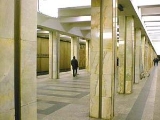
Shchukinskaya
Encyclopedia
Shchukinskaya is a station on the Tagansko-Krasnopresnenskaya Line
of the Moscow Metro
. Named after the village of Schukino before it was consumed by Moscow and became a municipality in the 1940s, it was opened on 30 December 1975. The design follows the original pillar-trispan (40 columns instead of 26). The pillars
are faced with different shades of pinkish marble
(from the Ukrainian deposit of Burovshchina) and punctuated by a vertical strip of anodized aluminum on each face. The walls are of corrugated, bronze
-coloured aluminum, an alloy of extensive strength and flexibility, adorned with decorative panels. The floor is covered with polished grey granite. The architects were Nina Aleshina, Smailova and Alekseev.
During the construction of the extension tunnel Oktyabrskoe Pole-Shchukinskaya a new engineering method was developed. Because the Moscow soil was sandy, the metro tunnels had traditionally been built using the open pit method (ie digging from the surface) or by restricting building work from passing under inhabited areas as cave-ins would have been very likely. For the Shchukinskaya tunnel however circular concrete blocks were pressed rather than mounted into the soil, and as this was done rapidly the elements did not have time to develop into heavy pressure and sap into the tunnel. This removed the need for festering a sand-cement mixture into the finish, thereby dramatically increasing the potential speed of construction, and saving on building materials. Another achievement was that no metal was used for the mounting of the tunnel blocks, instead a bitumen mixture formed from the pressure of the boring complex was used to join the blocks. As this was denser than the soil, there was no need for festering of the cement.
The entrances to the station are located near the intersection of Shchukinskaya Ulitsa and Ulitsa Marshala Vasilevskogo.
The station handles 93500 people daily.
Tagansko-Krasnopresnenskaya Line
The Tagansko-Krasnopresnenskaya is the busiest line of the Moscow Metro...
of the Moscow Metro
Moscow Metro
The Moscow Metro is a rapid transit system serving Moscow and the neighbouring town of Krasnogorsk. Opened in 1935 with one line and 13 stations, it was the first underground railway system in the Soviet Union. As of 2011, the Moscow Metro has 182 stations and its route length is . The system is...
. Named after the village of Schukino before it was consumed by Moscow and became a municipality in the 1940s, it was opened on 30 December 1975. The design follows the original pillar-trispan (40 columns instead of 26). The pillars
Column
A column or pillar in architecture and structural engineering is a vertical structural element that transmits, through compression, the weight of the structure above to other structural elements below. For the purpose of wind or earthquake engineering, columns may be designed to resist lateral forces...
are faced with different shades of pinkish marble
Marble
Marble is a metamorphic rock composed of recrystallized carbonate minerals, most commonly calcite or dolomite.Geologists use the term "marble" to refer to metamorphosed limestone; however stonemasons use the term more broadly to encompass unmetamorphosed limestone.Marble is commonly used for...
(from the Ukrainian deposit of Burovshchina) and punctuated by a vertical strip of anodized aluminum on each face. The walls are of corrugated, bronze
Bronze
Bronze is a metal alloy consisting primarily of copper, usually with tin as the main additive. It is hard and brittle, and it was particularly significant in antiquity, so much so that the Bronze Age was named after the metal...
-coloured aluminum, an alloy of extensive strength and flexibility, adorned with decorative panels. The floor is covered with polished grey granite. The architects were Nina Aleshina, Smailova and Alekseev.
During the construction of the extension tunnel Oktyabrskoe Pole-Shchukinskaya a new engineering method was developed. Because the Moscow soil was sandy, the metro tunnels had traditionally been built using the open pit method (ie digging from the surface) or by restricting building work from passing under inhabited areas as cave-ins would have been very likely. For the Shchukinskaya tunnel however circular concrete blocks were pressed rather than mounted into the soil, and as this was done rapidly the elements did not have time to develop into heavy pressure and sap into the tunnel. This removed the need for festering a sand-cement mixture into the finish, thereby dramatically increasing the potential speed of construction, and saving on building materials. Another achievement was that no metal was used for the mounting of the tunnel blocks, instead a bitumen mixture formed from the pressure of the boring complex was used to join the blocks. As this was denser than the soil, there was no need for festering of the cement.
The entrances to the station are located near the intersection of Shchukinskaya Ulitsa and Ulitsa Marshala Vasilevskogo.
The station handles 93500 people daily.
External links
- metro.ru
- mymetro.ru
- KartaMetro.info — Station location and exits on Moscow map (English/Russian)
- Yuri Gridchin's website

